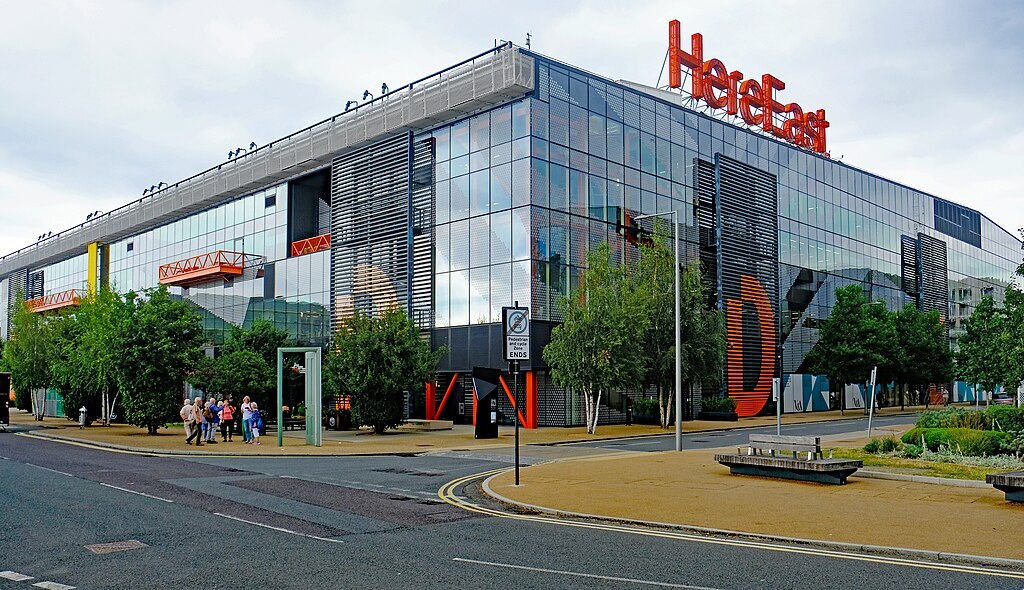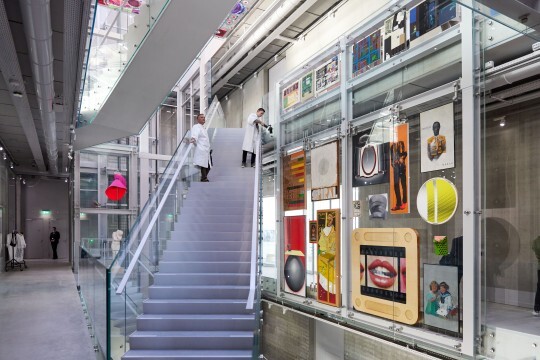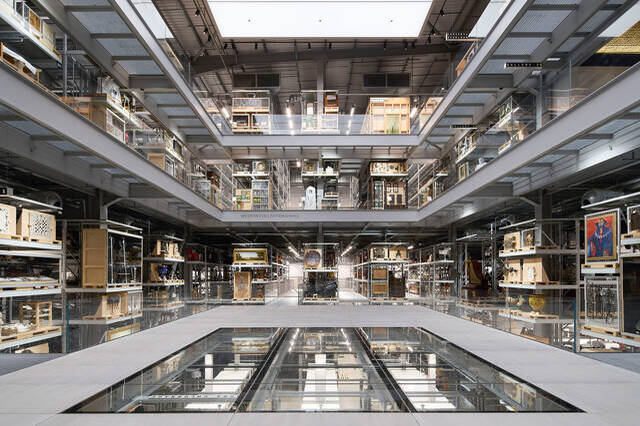
Reimagining the gallery
A few years ago, the late Mark Cousins, the AA ‘general studies’ guru, told me about an idea he had proposed to Zaha Hadid, writes Jeremy Melvin.
She had asked him to advise on a competition entry for an art gallery, I think in Cagliari, Sardinia. This was around the time that Herzog & de Meuron’s Schaulager Foundation in Basel was beginning to manoeuvre thinking about such projects away from the white- walled, evenly-lit, shadowed-gapped spaces that had dominated the presentation of contemporary art, at least since Max Gordon converted a former dairy in St John’s Wood into the first Saatchi Gallery.
The Schaulager houses works ‘of our time, but not yet recognised’ – as the foundation puts it – in individual cell-like spaces where scholars can be given access with a sort of hotel-room access card, Cousins suggested that works could be placed on a conveyer belt apparatus, and placed on order in front of visitors. Both addressed the perennial problem of galleries not having adequate storage space – let alone display space – for their collections. In each case, viewers could in effect curate their own exhibitions. Cousins’ suggestion anticipated the recent move towards galleries making the experience they offer more ‘performative’.
British readers of a certain age may find an echo in this of the once popular television show, the ‘Generation Game’, where successful contestants would be placed in front of a conveyer belt loaded with food blenders, colour televisions, stereo hi-fi systems, lava lamps and other paraphernalia of 1970s petit bourgeois domesticity. They could take home those which they could recall. Cousins cultural version was never built – the story did not relate whether the competition entry or idea were abandoned, or whether it was unsuccessful – but it would not be long before artists and curators started to ask for spaces with which they could interact, rather than the anonymous ‘neutrality’ of the Saatchi Gallery paradigm. Over several years that morphed into the introduction of performative elements in exhibitions.
Perhaps the most fruitful consequence of the trends Cousins intuited was the idea of reconfiguring the relationship between storage and display. Force majeur added to this, for example in the Depot, MVRDV’s building for the Boijmans van Beuningen Museum in Rotterdam. Once the museum authorities realised that refurbishing the original, asbestos-ridden building would take years, in an enlightened move they decided to commission a new building in a park in front the museum, which would provide storage for the decanted collection but also offer display space, allowing both of the institution’s main functions to continue during the building works.

Visitors can wander through the stored exhibits, housed on simple metal racks, maxmising what can be seen. Each space is easy to configure, and the total area allows some to be used for more formal, curated exhibitions. When I visited late last year there was a wonderful exhibition of works from the collection, selected by members of staff from the director to gallery attendants, which reflects another contemporary trend, that of ‘democratising’ the gallery. Displayed on simple Perspex screens, it was possible to see the work and its reverse side, often revealing hints of its making or provenance. It was also marvelously serendipitous, with Breughel’s Tower of Babel rubbing shoulders with seductive colourscapes by Mondrian.
Another space was given over to a fascinating display of the fruits of an ongoing research project into the museum’s collections of Renaissance drawings. In explaining the techniques of some of the masters, it was satisfying in a way that I have rarely felt in an exhibition, since seeing a show of Francis Bacon’s paintings alongside those by old masters who deeply influenced him, at the Beyeler Foundation in 2004. A potentially wonderful roof garden surmounts the Depot, just high enough to appreciate the skyline of the city with fortification from a nice café, even on a bleak, windswept Netherlandish autumn day.
Maybe surprisingly, London is now a major focus of significant cultural projects for the first time since the high point of lottery funding 25 years ago. The British Museum and National Gallery are undergoing far-reaching redevelopment fortified by nine-figure donations from the Crankstart Foundation and the Rausing family, as is the Wallace Collection, which originated through the collecting proclivities of three generations of one family but is now in quasi-public hands; there have been yet more moves to reposition the Barbican, and even the RIBA is getting in on the act, rehousing its drawings collection (venue not yet chosen) and turning its headquarters at 66 Portland Place, designed by the passenger liner specialist Grey Wornum in the 1930s, into a ‘house of architecture’. It is now closed for two years while work takes place.
In Oxford, the university has secured a large donation from Blackstone’s Stephen Schwarzman for a new humanities campus. Built back in London there is Here East, an initiative to line part of the Olympic Park in East London, now named for the late Queen Elizabeth II, with cultural venues, though mainly adjuncts to existing institutions rather than new ones. It has been masterplanned by a team including Allies & Morrison (who have designed the College of Fashion building for the University of the Arts) and O’Donnell & Tuomey.
The most interesting building completed so far, and closest to the trends described above, is the Diller Scofidio & Renfro ‘Storehouse’ for the V&A. It is the first to open of two V&A projects at Here East, a short walk from the cluster including the O’Donnell and Tuomey museum (scheduled for 2026), the same practice’s completed Sadlers Wells rehearsal and performance space, and the College of Fashion.

The Storehouse exterior is deceptively ordinary, a sheer glass wall leading to a spacious foyer with a small café and other amenities. From the entrance you see a staircase to the collections hall but the glimpse gives little away. The hall is magnificent, offering the spectacle of a gallery while rationally storing items from the huge collection. The 20m high volume has three floors, the top two organized around a central void which means it feels light, airy and invites views up, down and across it. The V&A is in effect the nation’s lumber room, with a huge collection of items that would not fit among the antiquities of the British Museum or the ‘fine art’ of the National or Tate Galleries. So almost by default it is the repository for decorative and fine arts, including design.
In the V&A Aston Webb building in Kensington, curators were desperate to prove their scholarship and creativity, putting displays together, for example, of every conceivable version of Russian samovars or other peripheral objects within conventional, dimly-lit galleries. By contrast, DSR’s design of the Storehouse celebrates the repository condition, helped by adapting the idea of the Depot, placing an almost inconceivable number of items on a flexible metal shelving system. It can display almost any object, from chests to chairs to paintings to clothing to part of buildings, such as a Spanish Islamic ceiling or the façade of the (sadly demolished) Robin Hood Gardens housing estate by the Smithsons. The anonymity of the shelving allows attention to focus on the objects, and for visitors to find their own order within the display, though there is some artful curation in the groupings. It is easy (even for someone of limited mobility) and enjoyable to walk around, not quite knowing what will be on the next shelf. Would it be ceramics, or fashion, or metal work? One could quite easily spend a lifetime surfing the vibe.
Each object has a label attached, rather as if it is waiting to be loaded onto a transporter, but which allows it to be identified and information accessed via an app. So visitors can curate their own experience, pre-selecting objects they want to see and being told of their location, or simply go with the flow. Compared to the incipient didacticism of the Kensington display of samovars – ‘you WILL learn about these objects whether you want to or not’ – the Storehouse respects its audiences’ predilections and attention span. This may have something to do with the distance from which one sees them: true some are close enough to touch but many are tantalizingly out of reach. Captions are sparse and anecdotal, but informative and often intriguing, reinforcing the sense of allowing visitors to find their own level of interpretation. Time will tell how the institution uses this fecund tool to offer new interpretations and discussions around its collection.
The British Museum has a very different collection – of eight million objects covering two million years of human history. Much of its present building in Bloomsbury was designed by Robert Smirke 200 years ago; since then it has been in a more or less continual state of evolution, acquiring the famous round reading room where Karl Marx wrote much of Das Kapital, its magnificent north wing designed by Sir John Burnett in the early 20th century and more recently for the millennium, the Foster-created Great Court in the awkward shape between the walls of what had been Robert Smirke’s square courtyard with his brother Sydney’s reading room at its centre. RSHP added the BM’s first purpose-designed temporary exhibition space and conservation workshops a decade ago. That it needs to keep evolving to meet the needs and expectations of its six million annual visitors is hardly a surprise, though no doubt a significant motor is the increasingly strident questioning of the legitimacy and provenance of much of its collections.
Its latest masterplan so far comprises three main elements: a centre for its archaeological collection outside London; an energy centre, on site but largely concealed to assist a transition to green power; and a highly visible element, the redesign and repositioning of the galleries on its western side, for which Lisa Gotmeh was appointed in February following a competition. The designs have yet to be revealed.
Having completed a major rehang, creating a learning centre and refurbishing the Sainsbury Wing earlier this year, the National Gallery would appear to be further down the path of adapting for the 21st century within an institution housed in an early 19th century neo-classical building (this one designed by William Wilkins). In September it announced a major new initiative called Project Domani (tomorrow in Italian, the ethnic origin of the director, Sir Gabriele Finaldi ). Two massive donations £150 million each from the Crankshaft Foundation (founded by the Welsh-born, California-based billionaire Michael Moretz) and the Julia Rausing Foundation, have been supplemented by a further £75 million in donations and reserves. The gallery thus has nearly £400 million, which is the closest estimate anyone will allow might be the cost of its proposed building. Fund-raising is ongoing and will cover other costs such as conservation and purchases. Part of that will be to boost its collection of modern and contemporary work (ending a division of interest with Tate), which the gallery sees as central to its mission to explain the history of painting as a continuous arc.
The site on Orange Street, behind the Sainsbury Wing on a side street that leads past the Westminster Reference Library towards Leicester Square, is occupied by a shabby 1960s slab, which has offices (including various gallery departments) and an hotel. Having acquired the site in 1998 with the intention of redeveloping it to expand the gallery, the imminent end of the lease represented an opportunity to do so. For this initiative the gallery has launched a two-stage competition with expressions of interest due in October with a selection of up to six architects slated to be announced in December.
Competitors will be expected to upgrade the public realm – a distant echo of Richard Rogers’ famous and controversial entry to a competition for the site of what became the Sainsbury Wing in the early 1980s, which kickstarted his various initiatives for improving central London’s public spaces – as well as providing extra gallery space for the existing collection as well as new purchases of modern and contemporary work, temporary exhibitions and offices. A central requirement will be to link the new galleries to the existing Sainsbury Wing, designed by Venturi Scott Brown and recently repositioned by Annabel Selldorf, and the original Wilkins building. Both offer rather fine top-lit enfilades.
Rather smaller than most of its European peers, the British National Gallery is unusual in not growing out of a Royal Collection as did the Louvre, the Prado and various German museums. It originated with the British government’s purchase of the Angerstein collection, quickly supplemented by a collection from Sir George Beaumont, and over the following two centuries various purchases and further donations such as that of John, Simon and Timothy Sainsbury for the eponymous wing, and from Paul Getty Jnr who made his home in Britain and reputedly wanted the gallery to be able to compete with his father’s institution in California.
Perhaps the greatest of all private collections created in Britain is the Wallace Collection, based in London’s Marylebone district. It represents the efforts of three generations of the same family, the second and third Marquesses of Hertford (the elder supposedly the model for Lord Steyn in Thackeray’s Vanity Fair) and the illegitimate son of the younger marquess, Sir Richard Wallace. Its greatest picture gallery holds Poussin’s Dance to the Music of Time (immortalized in Anthony Powell’s 12-volume series of novels of that name), as well as alpha works by Titian, Rubens and Frans Hals. But the collection caters for numerous tastes, with Fragonard’s Ancien Regime soft porn, and a large collection of arms and armour. It is scheduled for a significant overhaul by Annabel Selldorf, whose work at the National Gallery included working with Hannah Lawson who designed the learning centre. The two are collaborating again at the Wallace.
London has had its share of disappointments in cultural projects – Diller Scofidio’s proposed concert hall at the Barbican was quietly axed, but at a point where the whole notion of culture is under review, and with a government that is hardly receptive to cultural projects, several of London’s great institutions arez addressing the challenges, successfully raising funds and coming up with ambitious proposals. Harbinger or swansong? Not yet clear.
Founder Partner






